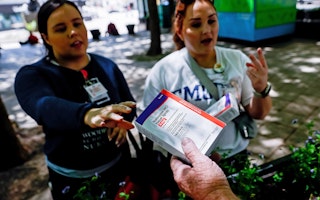Addicted to Courts
By Nastassia Walsh
The numbers tell the story.
- 29: The percent of admissions to state prisons that were for drug offenses in 2008.
- 1,223: The percentage increase in incarceration for drug offenses since 1980.
- 1,600,000: The number of arrests for drug offenses in 2009, 80 percent of which were for possession.
- $68,000,000,000: Taxpayer dollars spent yearly to incarcerate over two million people across the United States.
A few more numbers: Of the 9 percent of people in the U.S. who are classified with substance abuse or dependence on drugs or alcohol, less than a fourth receive treatment. For those who do, over a third (37 percent) are referred by the criminal justice system, the largest single source of referrals to substance abuse treatment nationally. Arrests for drug offenses continue to increase at an unsustainable rate.
With states facing ongoing budget crises, it is crucial that policymakers support drug policies and programs that work. By "work," we mean those that are cost-effective, protect community safety, and improve people’s lives. Unfortunately, by and large the prescription for addressing substance abuse problems remains an exorbitantly expensive dose of prison, instead of community-based treatment and diversion programs that are both less costly and more effective.
For drug abuse and a host of other social issues, the U.S. appears to be addicted to courts. We have drug courts, mental health courts, truancy courts, gambling courts, homelessness courts...the list goes on and on. Why, we at the Justice Policy Institute ask, are courts and the justice system—an inherently punitive, punishment-based model—the response to what are inherently social and public health issues?
It is increasingly important that we direct a critical eye toward the growing popularity of drug courts and ask, are there better options? A troubling This American Life radio program, Very Tough Love, which aired in March 2011, chronicles women in the drug court of Judge Amanda Williams in Glynn County, Georgia. We hear the story of Lindsey Dills, “who forges two checks on her parents' checking account when she's 17, one for $40 and one for $60, and ends up in drug court for five and a half years, including 14 months behind bars, and then she serves another five years after that—six months of it in Arrendale State Prison, the other four and a half on probation.”
While this is an extreme example, research from our report, Addicted to Courts: How a Growing Dependence on Drug Courts Impacts People and Communities, shows that drug courts widen the net of criminal justice involvement, needlessly involving people in the justice system that would be better served by treatment in the community.
As long as drug courts are seen as the solution we will not see attention drawn to the real problem: inadequate resources for people before they get caught up in the justice system. To the extent that drug court programs are utilized, they should be reserved only for people who would otherwise be prison-bound. Investments should be, must be, made to ensure people get treatment when they need it, and where they need it, and before the problem escalates to a dangerous or unhealthy situation.
In the end, this isn’t just a numbers game. It’s about improving the success and well-being of people and communities. And reducing the numbers of people who end up in the justice system because of drugs is a part of that process.
Nastassia Walsh is a Research Associate at the Justice Policy Institute, which is a grantee of the Open Society Foundations.
Nastassia Walsh is a research associate at the Justice Policy Institute, which is a grantee of the Open Society Foundations.


